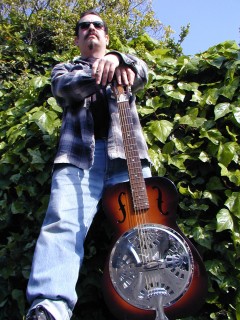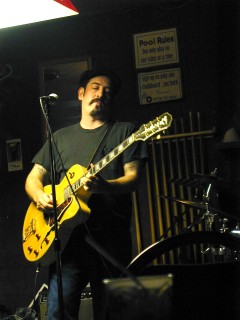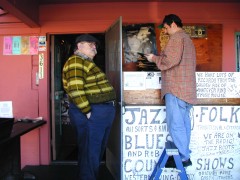Yesterday And Today
Retrospection in “Blue”–Buddy’s Many Hats
Part 1
For the appropriate memory rush that accompanied the 20th anniversary of Dan (aka Country Dick Montana) McLain’s death–Jon Kanis’ comprehensive tribute cover in last November’s Troubadour–and the more recent musical celebration at the Belly Up Tavern, it’s mind boggling to consider that we will soon be remembering a milestone date in the passing of one of his former musical partners-in-crime.
April 2 marks the tenth anniversary of Bernard Seigal–aka Buddy Blue. Try wrapping yourself around that passage in time for a minute. In the decade that’s passed, there’s been new blood pumped into the local music scene, new venues opening for live performances, and new technology created for artists to be heard. Yet for all the excitement, San Diego and the rest of SoCal is admittedly a duller place without the self-proclaimed “charming curmudgeon” holding court.
Hailing from Syracuse, New York, Buddy relocated to the West Coast with his family in the ’70s. He retained his East Coast edge in personality and in dress (no known photos of Buddy posing in a Hawaiian print and flip-flops have ever crossed the Troubadour copy desk). But for his crusty exterior, he displayed a deep commitment to his songwriting craft and a devotion to family and friends. And he could wear so many symbolic hats. Those who know Buddy for his impressive discography and live shows only know part of his story. On his 10th anniversary, we’ll try on some of Buddy’s hats through the memories of San Diegans who can attest to Buddy’s diverse talents.
THE MUSICIAN
Prior to Buddy’s best known role–as one of the original Beat Farmers–he was in an earlier roots-oriented band called the Rockin’ Roulettes. “A [semi-punk] band I was playing in had just broken up and the bass player [Tim McCarthy] and myself were looking to start something new, maybe a little more Americana or roots, if you will,” said local drummer Mark Williams. “Tim saw an ad for a bassist in the Reader and called, who turned out to be Buddy. Buddy said he wasn’t looking to join a band, but simply find a bass player for some East County country project. I called Buddy back later and gave him the hard sell–hell, he sang and played guitar, and he agreed to come over and jam. That night the three of us played and Buddy sang his ass off without so much as a microphone. As it turned out he liked us and promptly dumped his country band and the Rockin’ Roulettes were born. Shortly after that Buddy married and then quickly divorced and moved in with myself and Chris Sullivan [Penetrators]. The Roulettes were primarily a rockabilly band playing a lot of originals, however with Buddy’s knowledge of deep catalog blues and obscure soul stuff we would mix it up throughout the night… imagine Gene Vincent followed by JJ Jackson’s “But It’s Alright.”
Williams said “Buddy could be a curmudgeon, but it was my experience that he was hard pressed to lie… in fact he was brutally honest, often when you didn’t want to hear it. I grew to really appreciate that. He was also one of the most natural talents I’ve ever seen and could sing just about anything, often, too often actually, crooning “My Funny Valentine” around the house almost daily. His liver and onions and machaca burritos were pretty decent also.
“In October 2005 the Farmers played my birthday party, which was really special. Less than six months later he was gone. After a decade what I might miss the most is the occasional phone call and that unmistakable voice growling “Willie, lets go eat some sushi.”
It was actually at a 1983 Rockin’ Roulettes show at the East San Diego location of Bodie’s nightclub where McLain and guitarist Jerry Raney walked in with the intention of recruiting Buddy for the Beat Farmers. Raney was impressed by Buddy’s talent from their earliest jam sessions. “The lyrics to his songs just seem to flow out of him,” Raney recalled. “And he was writing some really soulful songs”. In hindsight 30 years later, Raney believed there were two main factors in Buddy’s well-documented departure from the Beat Farmers in 1986. “I think part of it had to do with Buddy and Country Dick not getting along at the time. But there was also the troubles with Curb Records [the label the Farmers signed with after their time with Rhino Records]. I think that really got to Buddy after a while. Curb wanted us to record other people’s songs to see if we could have hits with them! We were already known as a band with songwriters. Curb kept trying to push us in that direction, and it affected Buddy greatly. I just think it was the straw which broke the camel’s back.” Buddy would eventually find reconciliation with Raney and the other Farmers. “When we were playing live, it seemed so natural, like we had playing together for years,” said Raney. “At parties, he would show his fun-loving side. He used to like to pretend he was a gangster, saying all types of crazy stuff, and then he’d go get a bottle of aftershave and slap it on people.”
After being part of the “cowpunk” movement, Buddy organized a band that drew upon his memories of Syracuse. Calling themselves The Jacks, the group played “Genesee Cream Ale Rock” [named after the popular beer brewed in upstate New York] and in their most successful lineup featured New York natives Chris Sullivan on bass and the late Mighty Joe Longa on keyboards, along with San Diego-raised drummer Jack Pinney, formerly of Iron Butterfly and Glory fame. “Our sound was a mix between the Rascals, Booker T and the MGs, and Little Steven and the Disciples of Soul,” said Sullivan. The band recorded a strong LP, The Jacks Are Wild, which unfortunately seemed destined to be categorized under the file of “Great Albums Which Were Never Heard.” The main problem stemmed from the band’s decision to sign with Rounder Records, a label that managed to break out nationally a Delaware guitarist named George Thorogood but encountered difficulty marketing a band from San Diego. “At first, we were told that the album would be the label’s first CD but then they couldn’t make up their minds whether they were going to release it as an LP or CD,” said Sullivan. “They dropped the ball on everything they said they were going to do.” Looking past the confusion of the album’s distribution problems, Sullivan was still impressed by “the band’s chemistry and camaraderie. As great as our musical camaraderie was, what I remember most about Buddy were the endless practical jokes we’d play on each other.”
THE STUDIO HAT
Over the years, Buddy produced or did session work with an eclectic variety of artists, from the certifiably crazy Screamin’ Jay Hawkins to the sultry Joy Eden Harrison to the neophyte recordings by the Rugburns. Although Buddy knew the sound he wanted for his own songs, Sven-Erik Seaholm was behind the board to help him through many a recording night. “I did the demos for the [Buddy Blue Band’s] Dive Bar Casanovas and produced all of his subsequent solo recordings: Greasy Jass, Dipsomania, Pretend It’s Okay, and Sordid Lives, as well as The Farmers’ Loaded and Fulmination and compiled The Flying Putos’ Noodles Tapes.” Seaholm believed “Buddy was always looking for the best version of the truth. He was a man of encyclopedic musical knowledge and could play just about any damn thing he set his mind to. That said, he was ultimately looking for a longer lasting version of all the cassette tapes he was constantly shoving into his car’s stereo system or wearing out the needles of his vintage Victrola with Slim Galliard, Cab Calloway, Howlin’ Wolf, the Rascals, Blodwyn Pig, Screamin’ Jay Hawkins, Hank Williams… from garage rock to supper club jazz, he wasn’t just immersed in music, he was steeped in it and wanted that old stylistic teabag to stink like it.”
It appeared from the very beginning that Buddy and Sven were musically attached at the hip. “Buddy and I used to work at The Wherehouse record store in Grossmont Center in the mid-’80s. He’d recently left the Beat Farmers and was playing with his new band, the Jacks at that time. It was a perfect job for a couple of music-obsessed guys like us, except that Buddy at that time was decidedly not a people person. So we worked out an arrangement where he would sit at the front counter and smoke and edumicate me with whatever he wanted to play over the sound system. Meanwhile I would gleefully help customers and talk music with them. When they were ready, Buddy would ring up their purchases, make approving or disgusted faces at their selections and grunt intermittently. It was a wonderfully symbiotic relationship, from which I gained a ton of knowledge and heaping portion of respect for his curmudgeonly demeanor.” Later, when they began their studio collaboration, Seaholm could see that Buddy’s “strengths were polar opposite: He could be a complete bastard when he wasn’t getting what he wanted and drove many of his band members crazy, if not completely out of the band! He would work them ragged and then go have a cigarette, or three, and come back even more insistent that they get it right until they did. Then, he would be the sweetest, kindest most supportive guy in the world. He paid his bands fairly, but they earned every damn penny of it! As a musician, his grasp of feel… of groove… of vibe were unparalleled. His quest for the gutbucket essence of rock’s greasiest, sleaziest primordial ooze rendered unto him the ability to whip a room in to a veritable frenzy. Seriously, he’d have people sweating, heaving, dancing, and taking off their clothes in a hallucinogenic state of total enrapture. I swore I thought Pete’s Place in La Mesa [Buddy’s favorite musical home in his later years] was gonna just crumble down around us a couple of times and I doubt anyone would have noticed. It was drunken dirty magic. I miss his ability to say exactly what was on his mind and not give the tiniest of s__ for the consequences. He never suffered a single fool gladly and made us all better for it, somehow. If he was known as a jerk as a result, he really didn’t care. It was more important that the music we all made or listened to be a good as could be, so that we could all enjoy life as fully as he did.” Mostly though, Sven misses Buddy’s “sweetness. He loved his friends deeply and steadfastly. He gave us all so many wonderful nicknames, like we were all kids from the same block. I once asked him, ‘Buddy, why do you give people all these names? How do you keep track of them all?’ He just clenched his omni-present Marlboro Light between his teeth and said, “The special people get the special names, Svenny.” He was a special character and I miss his presence in every moment of every single day.”
Stay tuned for Part 2 of the Buddy Blue story in next month’s issue!









